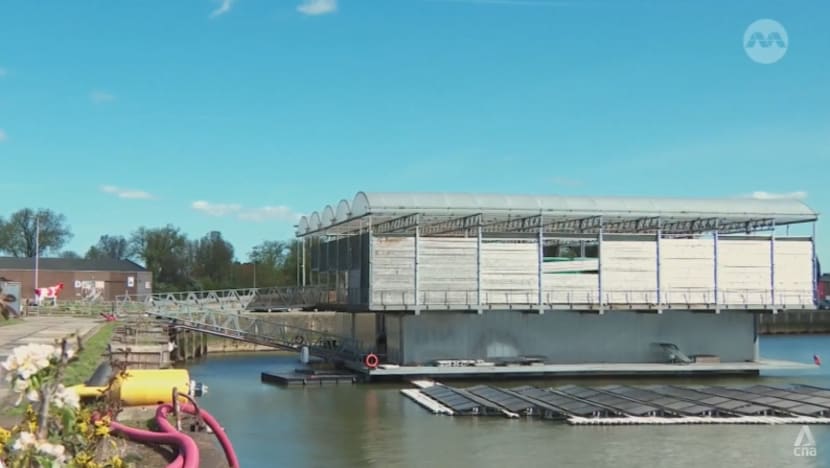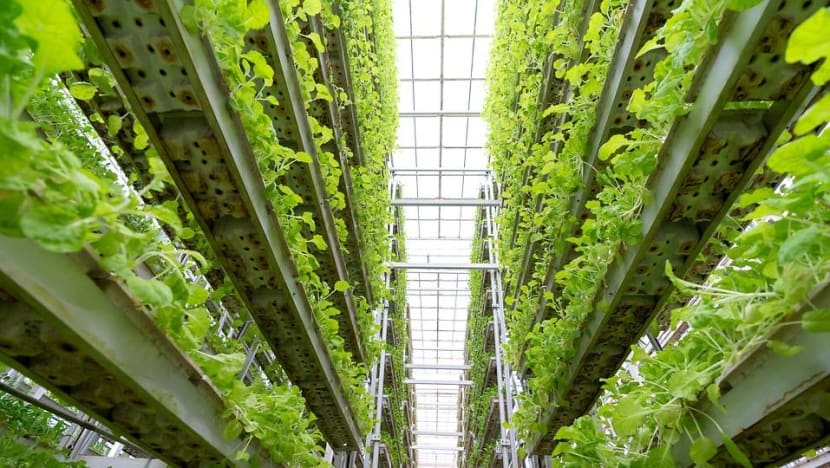ROTTERDAM: The Netherlands may be well-known for its tulips and gouda cheese, but the European nation with limited land is also a leader in agricultural technology.
Its major port city of Rotterdam boasts the world's first farm that is built on water.
Floating Farm – like its name suggests – is a dairy farm that does not take up any land space. It is constructed offshore at Merwehaven harbour, off the Nieuwe Maas river.
The farm runs on solar power and automation, and champions circular agriculture by repurposing waste from food processing processes.
Cow feed comes in the form of leftovers from neighbouring shops – bread from a bakery, greens from a food bank, and spent grain that is high in protein from a brewery.
Manure is processed and turned into fertiliser – a process the company said cuts methane emissions by about 60 per cent. The resulting product is used for growing lettuce and herbs in its vertical farming installation housed in its basement.
Technology plays a major role in the farm’s day-to-day operations.
Its 30 cows are milked by a robot and can produce 600 litres of milk daily, which is then used to make various dairy products – such as buttermilk, yoghurt and cheese – and sold to the community.
A manure robot keeps the stable clean. Rainwater is collected and filtered for cows to consume while floating solar panels supply energy.

Floating Farm, a dairy farm built on water, runs on solar power and automation, and can produce 600 litres of milk daily.
Ms Minke van Wingerden, a partner at the farm, said such a concept mitigates the negative impact of disasters such as floods on food supply chains, especially in Rotterdam, where 90 per cent of the city lies below sea level.
“A floating farm, whether the water is high or low, will be able to continue to produce fresh, healthy food for the city,” she said.
With high automation, the farm only requires four employees to maintain.
“There's hardly anything to do by hand. Employees watch the cameras to see if the cows are doing well. We also have two specialists processing the milk,” Ms van Wingerden said.
“The farm of the future is highly automated, with a lot of innovations. This means not that many hands are needed (on deck).”
The firm has plans for more farms nearby and is also lending its expertise to other land-scarce countries.
Ms van Wingerden said that Singapore, in particular, could benefit from such an agritech model.
“Singapore imports a lot of food. Imports come with a lot of waste. The transport also contributes to pollution,” she said.
“Singapore has a lot of water surrounding it. So why not make farms (in the waters) around, so you can be much more self-sufficient and avoid incurring transport and food loss?”
Industry players in Singapore said they have considered adapting the concept but found it not feasible in a market with less demand for dairy, and where farming is not often economical.
“It never took off because the cost was too much. The capital investment is very high and there's no economies of scale,” said Professor Veera Sekaran, head of the National University of Singapore’s Regenerative Agritech Centre.
“Singapore’s sea lanes are also very busy and congested. There are container ships queuing up to go into port, and some coastal areas are too narrow.”
He added that there are fears of biohazard waste leaking into the sea which could lead to environmental or diplomatic concerns with neighbouring countries.
Food security dilemmas lead to questions on how to grow food safely and efficiently in countries like Singapore, without taking up too much space.
One solution is vertical farms, which the Dutch are well known for.
At agritech company Growy's set-up in the capital city of Amsterdam, robots do everything from seeding to packaging.
“(Technology) manages the whole farm for us. If we need to (check up on any of the plants), we can easily log in from our phones or laptops wherever we are in the world. We can send our robots to look for or do what we need,” said Ms Laura van de Kreeke, a farmer at the firm.
She said the high-tech systems not only streamline labour, they have also saved the company 90 per cent in water usage.
Growy is among global agritech companies laying down vertical farming roots in Singapore. It said its farm in Changi Logistics Centre will produce up to 500 tonnes of leafy greens annually.

Sky Greens is Singapore’s first farm to secure a new national standard for organic primary produce grown in or near an urban area. (Photo: Nespresso)
Prof Sekaran said there is value in the technology to help local farms manage costs and compete with imported produce.
“Now that we have a mandate for some self-sufficiency, we are actively pursuing, trying to get technology and other aspects of agriculture done within an urban context. As we do not have enough land, we need to try and find productivity solutions,” he said.
However, he added that the industry must think about what crop to grow, and where to set up.
“The problem is – we have got farmers trying to grow the same crops and all going to the same market. If you want to grow high-value stuff, it will compete with high value imports because the cost of production is high,” he said.
To boost its food security, Singapore wants to produce 30 per cent of its food needs locally by the year 2030. However, experts say the nation is still far from the target due to the high cost of domestic production, and not enough demand and supply.


Continue reading...
Its major port city of Rotterdam boasts the world's first farm that is built on water.
Floating Farm – like its name suggests – is a dairy farm that does not take up any land space. It is constructed offshore at Merwehaven harbour, off the Nieuwe Maas river.
The farm runs on solar power and automation, and champions circular agriculture by repurposing waste from food processing processes.
Cow feed comes in the form of leftovers from neighbouring shops – bread from a bakery, greens from a food bank, and spent grain that is high in protein from a brewery.
Manure is processed and turned into fertiliser – a process the company said cuts methane emissions by about 60 per cent. The resulting product is used for growing lettuce and herbs in its vertical farming installation housed in its basement.
Technology plays a major role in the farm’s day-to-day operations.
Its 30 cows are milked by a robot and can produce 600 litres of milk daily, which is then used to make various dairy products – such as buttermilk, yoghurt and cheese – and sold to the community.
A manure robot keeps the stable clean. Rainwater is collected and filtered for cows to consume while floating solar panels supply energy.

Floating Farm, a dairy farm built on water, runs on solar power and automation, and can produce 600 litres of milk daily.
Ms Minke van Wingerden, a partner at the farm, said such a concept mitigates the negative impact of disasters such as floods on food supply chains, especially in Rotterdam, where 90 per cent of the city lies below sea level.
“A floating farm, whether the water is high or low, will be able to continue to produce fresh, healthy food for the city,” she said.
With high automation, the farm only requires four employees to maintain.
“There's hardly anything to do by hand. Employees watch the cameras to see if the cows are doing well. We also have two specialists processing the milk,” Ms van Wingerden said.
“The farm of the future is highly automated, with a lot of innovations. This means not that many hands are needed (on deck).”
The firm has plans for more farms nearby and is also lending its expertise to other land-scarce countries.
Ms van Wingerden said that Singapore, in particular, could benefit from such an agritech model.
“Singapore imports a lot of food. Imports come with a lot of waste. The transport also contributes to pollution,” she said.
“Singapore has a lot of water surrounding it. So why not make farms (in the waters) around, so you can be much more self-sufficient and avoid incurring transport and food loss?”
SG NOT SUITABLE FOR FLOATING FARMS
Industry players in Singapore said they have considered adapting the concept but found it not feasible in a market with less demand for dairy, and where farming is not often economical.
“It never took off because the cost was too much. The capital investment is very high and there's no economies of scale,” said Professor Veera Sekaran, head of the National University of Singapore’s Regenerative Agritech Centre.
“Singapore’s sea lanes are also very busy and congested. There are container ships queuing up to go into port, and some coastal areas are too narrow.”
He added that there are fears of biohazard waste leaking into the sea which could lead to environmental or diplomatic concerns with neighbouring countries.
VERTICAL FARMING COULD BE THE ANSWER
Food security dilemmas lead to questions on how to grow food safely and efficiently in countries like Singapore, without taking up too much space.
One solution is vertical farms, which the Dutch are well known for.
At agritech company Growy's set-up in the capital city of Amsterdam, robots do everything from seeding to packaging.
“(Technology) manages the whole farm for us. If we need to (check up on any of the plants), we can easily log in from our phones or laptops wherever we are in the world. We can send our robots to look for or do what we need,” said Ms Laura van de Kreeke, a farmer at the firm.
She said the high-tech systems not only streamline labour, they have also saved the company 90 per cent in water usage.
Growy is among global agritech companies laying down vertical farming roots in Singapore. It said its farm in Changi Logistics Centre will produce up to 500 tonnes of leafy greens annually.

Sky Greens is Singapore’s first farm to secure a new national standard for organic primary produce grown in or near an urban area. (Photo: Nespresso)
SINGAPORE'S 30 BY 30 GOAL
Prof Sekaran said there is value in the technology to help local farms manage costs and compete with imported produce.
“Now that we have a mandate for some self-sufficiency, we are actively pursuing, trying to get technology and other aspects of agriculture done within an urban context. As we do not have enough land, we need to try and find productivity solutions,” he said.
However, he added that the industry must think about what crop to grow, and where to set up.
“The problem is – we have got farmers trying to grow the same crops and all going to the same market. If you want to grow high-value stuff, it will compete with high value imports because the cost of production is high,” he said.
To boost its food security, Singapore wants to produce 30 per cent of its food needs locally by the year 2030. However, experts say the nation is still far from the target due to the high cost of domestic production, and not enough demand and supply.
Related:


Continue reading...


